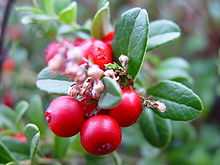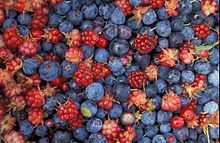Berry
The botanical definition of a berry is a fleshy fruit produced from a single flower and containing one ovary. Grapes and bananas are two common examples. The berry is the most common type of fleshy fruit in which the entire ovary wall ripens into an edible pericarp. They may have one or more carpels. The seeds are usually embedded in the fleshy interior of the ovary, but there are some non-fleshy exceptions, such as peppers, that have air rather than pulp around their seeds.
A plant that bears berries is said to be bacciferous or baccate (a fruit that resembles a berry, whether it actually is a berry or not, can also be called "baccate").
In everyday English, "berry" is a term for any small edible fruit. These "berries" are usually juicy, round, brightly coloured, sweet or sour, and do not have a stone or pit, although many seeds may be present.
Many berries, such as the tomato, are edible, but others in the same family, such as the fruits of the deadly nightshade (Atropa belladonna) are poisonous to humans.
Botanical berries

In botanical language, a berry is a simple fruit having seeds and pulp produced from a single ovary; the ovary can be inferior or superior.
Examples of botanical berries include:
- Avocado (Persea americana) a one-seeded berry
- Banana[1][2]
- Barberry (Berberis; Berberidaceae)
- Bearberry (Arctostaphylos spp.)
- Bilberry
- Blueberry
- Coffee berries
- Cranberry
- Crowberry (Empetrum spp.)
- Currant (Ribes spp.; Grossulariaceae), red, black, and white types
- Elderberry (Sambucus niger; Adoxaceae)
- Gooseberry (Ribes spp.; Grossulariaceae)
- Indian gooseberry (Phyllanthus emblica)
- Garcinia gummi-gutta, Garcinia mangostana, and Garcinia indica (Vrikshamla)
- Goji berries (Wolfberry)
- Grape, Vitis vinifera
- Honeysuckle: the berries of some species are edible and are called honeyberries, but others are poisonous (Lonicera spp.; Caprifoliaceae)
- Lingonberry/Cowberry (Vaccinium vitis-idaea)
- Persimmon
- Mayapple (Podophyllum spp.; Berberidaceae)
- Oregon-grape (Mahonia aquifolium; Berberidaceae)
- Pumpkin
- Strawberry tree (Arbutus unedo), not to be confused with the strawberry (Fragaria)
- Tomato and other species of the family Solanaceae
- Watermelon
Modified berries
The fruit of citrus, such as the orange, kumquat and lemon, is a berry with a thick rind and a very juicy interior that is given the special name hesperidium.
Berries which develop from an inferior ovary are sometimes termed epigynous berries or false berries, as opposed to true berries which develop from a superior ovary. In epigynous berries, the berry includes tissue derived from parts of the flower besides the ovary. The floral tube, formed from the basal part of the sepals, petals and stamens can become fleshy at maturity and is united with the ovary to form the fruit. Common fruits that are sometimes classified as epigynous berries include bananas, coffee, members of the genus Vaccinium (e.g., cranberries and blueberries), and members of the family Cucurbitaceae (e.g., cucumbers, melons and squash).[3]
Another specialized term is also used for Cucurbitaceae fruits, which are modified to have a hard outer rind, and are given the special name pepo. While pepos are most common in the Cucurbitaceae, the fruits of Passiflora and Carica are sometimes also considered pepos.[4]
Fruits not botanical berries
.jpg)
Many fruits commonly referred to as berries are not actual berries by the scientific definition, but fall into one of the following categories:
Drupes
Drupes are fleshy fruits produced from a (usually) single-seeded ovary with a hard stony layer (called the endocarp) surrounding the seed. Familiar examples include the stonefruits of Prunus species (peaches, plums and cherries), olives, coconut and bayberry. Other drupe-like fruits with a single seed that lack the stony endocarp include sea-buckthorn (Hippophae rhamnoides, Elaeagnaceae), an achene surrounded by the swollen hypanthium, which provides the fleshy layer.
Pomes
The pome fruits produced by plants in subtribe Pyrinae of family Rosaceae, such as apples and pears, have a structure (the core) that clearly separates the seeds from the ovary tissue. However, some of the smaller pomes are sometimes referred to as berries. Bright red haws from Crataegus are sometimes called hawberries. Amelanchier pomes become so soft at maturity that they resemble a blueberry and are known as Juneberries or Saskatoon berries.
Aggregate fruits

Aggregate fruits contain seeds from different ovaries of a single flower. Examples commonly called "berries" include members of the Rubus genus, such as blackberry and raspberry. Other large aggregate fruits, such as soursop (Annona muricata) are not usually called "berries".
Multiple fruits
Multiple fruits include the fruits of multiple flowers that are merged or packed closely together. The mulberry is a berry-like example of a multiple fruit; it develops from a cluster of tiny separate flowers that become compressed as they develop into fruit.[5]
Accessory fruits
In accessory fruits, the edible part is not generated by the ovary. Berry-like examples include:
- Strawberry - the aggregate of seed-like achenes is actually the "fruit", derived from an aggregate of ovaries, and the fleshy part develops from the receptacle.
- Gurbir, Duchesnea indica - structured just like a strawberry
- Sea grape (Coccoloba uvifera; Polygonaceae) - the fruit is a dry capsule surrounded by fleshy calyx
- Wintergreen (Gaultheria procumbens) - the fruit is a dry capsule surrounded by fleshy calyx
Color and potential health benefits
Berries are typically of a contrasting color to their background (often of green leaves), making them visible and attractive to frugivorous animals and birds. This assists the wide dispersal of the plants' seeds.
Berry colors are due to natural plant pigments, many of which are polyphenols, such as the flavonoids, anthocyanins, and tannins, localized mainly in berry skins and seeds.[6] Although berry pigments have antioxidant properties in vitro,[7] there is no physiological evidence established to date that berry polyphenols have actual antioxidant functions within the human body. Consequently, it is not permitted to claim that foods containing polyphenols have antioxidant health value on product labels in the United States and Europe.[8][9]
National commercial production
| Berries production in thousand tonnes (2012) Aggregated data from: FAOSTAT[10] This includes blueberries, cranberries, currants, | |
|---|---|
| USA | 2074 |
| Russia | 710 |
| Poland | 553 |
| Mexico | 524 |
| Turkey | 432 |
| Spain | 319 |
| Canada | 282 |
| Germany | 258 |
| Egypt | 243 |
| Iran | 214 |
See also
Notes
- ↑ "Banana from ''Fruits of Warm Climates'' by Julia Morton". Hort.purdue.edu. Archived from the original on 2009-04-15. Retrieved 2009-04-16.
- ↑ Armstrong, Wayne P. "Identification Of Major Fruit Types". Wayne's Word: An On-Line Textbook of Natural History. Retrieved 2013-08-17.
- ↑ Gupta, P.K. (2007). Genetics Classical To Modern. Rastogi Publications. ISBN 978-81-7133-896-2.
- ↑ "A Systematic Treatment of Fruit Types". Worldbotanical.com. Retrieved 2013-08-26.
- ↑ The American Heritage Science Dictionary. Google Books. Retrieved 2013-08-26.
- ↑ Wrolstad RE (2001). "The Possible Health Benefits of Anthocyanin Pigments and Polyphenolics". Linus Pauling Institute, Oregon State University, Corvallis. Retrieved 7 July 2014.
- ↑ Wu X, Beecher GR, Holden JM, Haytowitz DB, Gebhardt SE, Prior RL; Beecher; Holden; Haytowitz; Gebhardt; Prior (June 2004). "Lipophilic and hydrophilic antioxidant capacities of common foods in the United States". Journal of Agricultural and Food Chemistry 52 (12): 4026–37. doi:10.1021/jf049696w. PMID 15186133.
- ↑ Guidance for Industry, Food Labeling; Nutrient Content Claims; Definition for "High Potency" and Definition for "Antioxidant" for Use in Nutrient Content Claims for Dietary Supplements and Conventional Foods U.S. Department of Health and Human Services, Food and Drug Administration, Center for Food Safety and Applied Nutrition, June 2008
- ↑ EFSA Panel on Dietetic Products, Nutrition and Allergies (NDA)2, 3 (2010). "Scientific Opinion on the substantiation of health claims related to various food(s)/food constituent(s) and protection of cells from premature aging, antioxidant activity, antioxidant content and antioxidant properties, and protection of DNA, proteins and lipids from oxidative damage pursuant to Article 13(1) of Regulation (EC) No 1924/20061" (PDF). EFSA Journal (Parma, Italy: European Food Safety Authority) 8 (2): 1489. doi:10.2903/j.efsa.2010.1489 (inactive 2015-01-10).
- ↑ http://faostat3.fao.org/faostat-gateway/go/to/download/Q/QC/E
Further reading
- Bowling, B.L. (2005). The Berry Grower's Companion. Timber Press. ISBN 978-0-88192-726-9
External links
| Wikimedia Commons has media related to: |
| Look up berry in Wiktionary, the free dictionary. |
| ||||||||||||||
| |||||||||||||||||||||||||||||||||||||||||||||
| ||||||||||||||||||||||||||||||||||||||||||||||||||||||||||||||||
